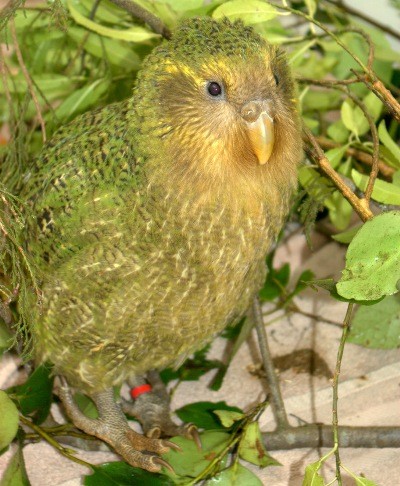Kakapo chicks move into the wild
 Wednesday, September 2, 2009 at 10:10
Wednesday, September 2, 2009 at 10:10  Young Kakapo. Photo: 100% Pure New Zealand
Young Kakapo. Photo: 100% Pure New Zealand
Five rare Kakapo chicks - the last from the 2009 breeding season - have been released from their temporary outdoor pens, and are now roaming free on an island sanctuary in New Zealand’s deep south.
The only survivors of their kind - a large flightless nocturnal bird that is the world’s rarest parrot - the chicks are members of a select family group of just 124 kakapoos.
Once prevalent throughout New Zealand, Kakapo now live only on predator-free Whenua Hou / Codfish Island, under the care of the Kakapo Recovery programme.
Hand-reared birds
The kakapo chicks spent up to six weeks in temporary outdoor pens while they were weaned off hand-rearing food and onto natural vegetation.
Before leaving their temporary home, each kakapo chick was fitted with a tracking transmitter. They were introduced in small groups into the wild in different parts of the island.
New Zealand Department of Conservation (DOC) staff members have been carefully following each chick while they explore their new habitat.
Natural behaviour
Kakapo recovery team leader Deidre Vercoe said being on predator-free Codfish Island was the best possible environment for a young kakapo to learn natural behaviour.
The chicks’ behaviours changed noticeably within the first few days of being released.
"One of the things they learned very quickly was to seek really good shelter. But some of the lessons about living in the wild have been a bit tough - one chick needed to be helped out of a small swamp!" Ms Vercoe said.
As the chicks become more confident and self-sufficient there would be less need for interaction with humans.
"A few chicks remain keen to be visited but others have become truly wild kakapo, running away from the hands that once fed them," Ms Vercoe said.
Kakapo chick management
The hand-feeding programme had been necessitated by a lack of ripe rimu tree fruit on the island sanctuary, Ms Vercoe said.
Some of the 27 mothers had struggled to keep up with the demands of their hungry offspring, so in order to ensure their survival some chicks had been hand-raised.
For the experts involved, this meant around-the-clock care and lots of feeds. Younger chicks needed at least 10 feeds a day while older ones were on about five feeds a day.
Of the 36 chicks that originally hatched, three had died and another seven were able to stay on the island with their mothers. The survivors include 20 males, and 13 females.
2009 kakapo breeding season
The hugely successful 2009 kakapo breeding season brings the critically endangered kakapo population to 124.
Releasing this season’s chicks onto the island was a significant milestone in the programme, according Paul Hemburrow, general manager of project partners New Zealand Aluminium Smelters Limited (NZAS).
"Now the kakapo chicks really have left the nest and are officially part of the national kakapo population. It’s a proud moment for everyone involved in this extraordinary kakapo season."
Kakap conservation partnership
DOC’s kakapo recovery work is supported by a partnership involving Rio Tinto Alcan NZ, New Zealand Aluminium Smelters, and the Forest & Bird organisation.
First signed over 20 years ago, the agreement is one of DOC’s longest running conservation partnerships and has already injected over NZ$3 million towards breeding programmes and predator proof sanctuaries for the flightless parrot.
Its aim is to establish at least one self-sustaining unmanaged population of kakapo in a protected habitat and to establish two or more other populations which may require ongoing management.
Earlier this year the partnership confirmed the population of threatened birds had cracked through the 100 mark. This crucial milestone doubled the number of birds that were alive a little over a decade ago.
 Strigops habroptilus - Kakapo | in
Strigops habroptilus - Kakapo | in  Captive breeding,
Captive breeding,  Release
Release 
